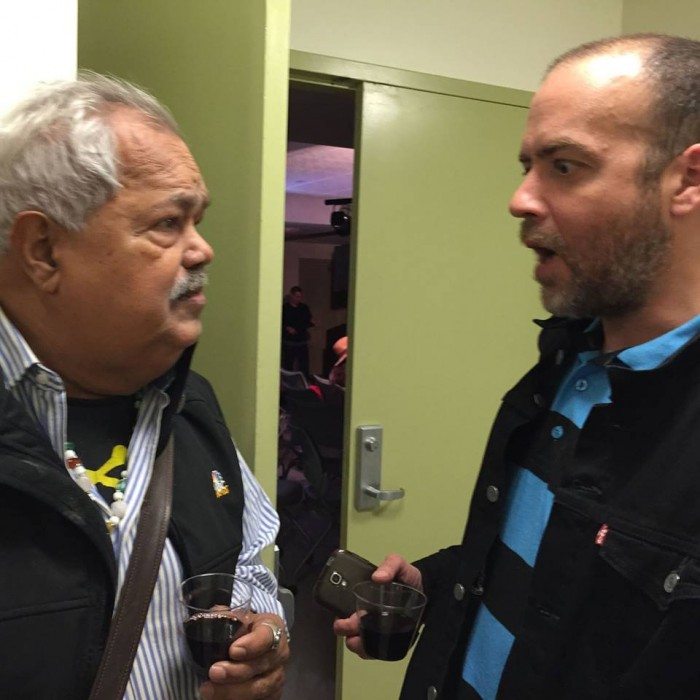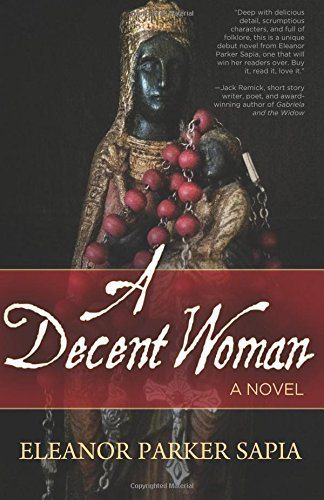Originally published by the author on his page.
As the New York City coordinator for Puerto Rico’s Festival de la Palabra, I have the unique fortune of working with authors and poets on both sides of the bilingual Puerto Rican divide. Someone once asked me why I expend so much energy in doing so and my answer was: If you’re experiencing Puerto Rican culture in only one language, you’re seeing it with only one eye (try it). No depth of perception.
Eleanor Parker Sapia’s A Decent Woman is an English-language historical novel set in Ponce in the early 1900s, which follows the friendship between Serafina Martínez (a pretty teenager of higher station in life, who winds up marrying into an affluent upper-crust family), and Ana Belén Opaku, a black Cuban midwife who begins delivering Serafina’s babies when Serafina is just sixteen.
These two central point-of-view characters contrast stunningly to bring the institutionalized oppression of women on all levels of Puerto Rican society to focus. Something we are still contending with today.
For Ana, it’s the relentless street survival skills she must hone as a confidant to prostitutes, in an era where male doctors are replacing midwives, where even the local priest is determined to destroy her. For Serafina it’s the humiliation and public shaming by her powerful philandering husband, Antonio San Patricio, who threatens to take everything away from her for confronting his infidelities.
Serafina and Ana’s friendship takes dangerous twists and turns and I was seduced by Parker Sapia’s dense historical drama and edge-of-your-seat suspense. This feminist hallmark in Puerto Rican letters brought to mind Esmeralda Santiago’s sprawling Conquistadora at first (not a bad thing), but A Decent Woman is a world all its own, one which will shock and dazzle readers with fictional elements interwoven with history.
The complex web of interconnecting characters is well executed and springs many surprises and cultivates much intrigue, and although women are oppressed and relegated to “baby machine” status, the secret spiritual underworld of espiritismo (spiritualism) is where they’re able to compensate for this thievery of civil rights and humanity. It’s when they’re among themselves that they bond and convene with the spirits, to foretell the future and seek guidance from their ancestors.
On an editorial note, there are glitches in Spanish grammar, but they don’t minimize the telling of this well-constructed tale. I mention this not to detract from Parker Sapia’s radiant achievement, but in hopes that editors and publishers might stumble upon this and realize that there are readers out there who will notice this and call it out. Edit your Spanish, por favor.
This book will be particularly valuable to readers of #BoricuaLit who do not read in Spanish, since it exposes stunning historical details we’re rarely taught in the diaspora: the devastation brought on by Hurricane San Ciriaco, the introduction of telephones to the industrializing island colony’s infrastructure and the colorful formation of the mosaic of belief systems that combined to create Puerto Rican espiritismo.
Like Conquistadora, this is well-crafted and well-researched literature, and there are an increasing number of authors in Parker Sapia’s company that are publishing richly-textured novels of historical and contemporary importance to the Puerto Rican people and others. These include Jonathan Marcantoni, author and CEO of Aignos Publishing, Manuel Meléndez, the horror and suspense writer based in Queens, New York, and Theresa Varela, a playwright and novelist based in Brooklyn, New York.
The president of the Mystery Writers of America New York Chapter himself, author Richie Narváez, is a Brooklyn Boricua, and teaches crime and noir fiction writing (alternating with me) at the Poe Park Visitors Center through the Bronx Council on the Arts. Bronx-based author Dahlma Llanos-Figueroa published a tale about Afro-Puerto Rican women, which begins in 19th Century Puerto Rico, Daughters of the Stone, in 2009.
Charles Rice-González, Sofia Quintero, Torrey Maldonado…there are too many to list here…
This new crop of talented and diverse authors is enriching the canon of Puerto Rican fiction with books that need to be bought, read and taught. While the New York literary scene has orbited around the Nuyorican movement and the island around universities in the San Juan metropolitan area, Parker Sapia (West Virginia) and Marcantoni (Colorado) live nowhere near these population centers and are writing in places where we are few in number, as I did for years when I first started in Portland, Oregon in the mid-1990s.


The author discussing the future of #BoricuaLit with Dr. Miguel Algarín, founder of the Nuyorican Poets Cafe
New York City is just one of many centers of the stateside Puerto Rican presence, the one that’s enjoyed the most notoriety and prestige for decades as a publishing capital and population center, but this is changing. Eleanor Parker Sapia’s crucial debut is proof of this and won’t be the end of it. Others I know of are writing at this very moment, in and out of New York City, and their books will come.
So how would I classify A Decent Woman and the works of the other authors I’ve mentioned? Post-Nuyorican English-language Puerto Rican literature.
This is #BoricuaLit.
So let the world know!
***
@CharlieVazquez is an author, one of the original Latino Rebels and the director of the Bronx Writers Center.




The Talmud must not be regarded http://utamadomino.com as an ordinary work, composed of twelve volumes; http://utamadomino.com/app/img/peraturan.html it posies absolutely no similarity http://utamadomino.com/app/img/jadwal.html to http://utamadomino.com/app/img/promo.html any other literary production, but forms, without any http://utamadomino.com/app/img/panduan.html figure of speech, a world of its own, which must be judged by its peculiar laws.
The Talmud contains much that http://utamadomino.com/ is frivolous of which it treats with http://dokterpoker.org/app/img/peraturan.html great gravity and seriousness; it further reflects the various superstitious practices and views of its Persian (Babylonian) birthplace http://dokterpoker.org/app/img/jadwal.html which presume the efficacy of http://dokterpoker.org/app/img/promo.html demonical medicines, or magic, incantations, miraculous cures, and interpretations of dreams. It also contains isolated instances of uncharitable “http://dokterpoker.org/app/img/panduan.html judgments and decrees http://dokterpoker.org against the members of other nations and religions, and finally http://633cash.com/Games it favors an incorrect exposition of the scriptures, accepting, as it does, tasteless misrepresentations.http://633cash.com/Games
The Babylonian http://633cash.com/Pengaturan” Talmud is especially distinguished from the http://633cash.com/Daftar Jerusalem or Palestine Talmud by http://633cash.com/Promo the flights of thought, the penetration of http://633cash.com/Deposit mind, the flashes of genius, which rise and vanish again. It was for http://633cash.com/Withdraw this reason that the Babylonian rather http://633cash.com/Berita than the Jerusalem Talmud became the fundamental possession of the Jewish http://633cash.com/Girl Race, its life breath, http://633cash.com/Livescore its very soul, nature and mankind, http://yakuza4d.com/ powers and events, were for the Jewish http://yakuza4d.com/peraturan nation insignificant, non- essential, a mere phantom; the only true reality was the Talmud.” (Professor H. Graetz, History of the Jews).
And finally it came Spain’s turn. http://yakuza4d.com/home Persecution had occurred there on “http://yakuza4d.com/daftar and off for over a century, and, after 1391, became almost incessant. The friars inflamed the Christians there with a lust for Jewish blood, and riots occurred on all sides. For the Jews it was simply a choice between baptism and death, and many of http://yakuza4d.com/cara_main them submitted http://yakuza4d.com/hasil to baptism.
But almost always conversion on thee terms http://yakuza4d.com/buku_mimpi was only outward and http://raksasapoker.com/app/img/peraturan.html false. Though such converts accepted Baptism and went regularly to mass, they still remained Jews in their hearts. They http://raksasapoker.com/app/img/jadwal.html were called Marrano, ‘http://raksasapoker.com/app/img/promo.html Accursed Ones,’ and there http://raksasapoker.com/app/img/panduan.html were perhaps a hundred thousand of them. Often they possessed enormous wealth. Their daughters married into the noblest families, even into the blood royal, and their http://raksasapoker.com/ sons sometimes entered the Church and rose to the highest offices. It is said that even one of the popes was of this Marrano stock.